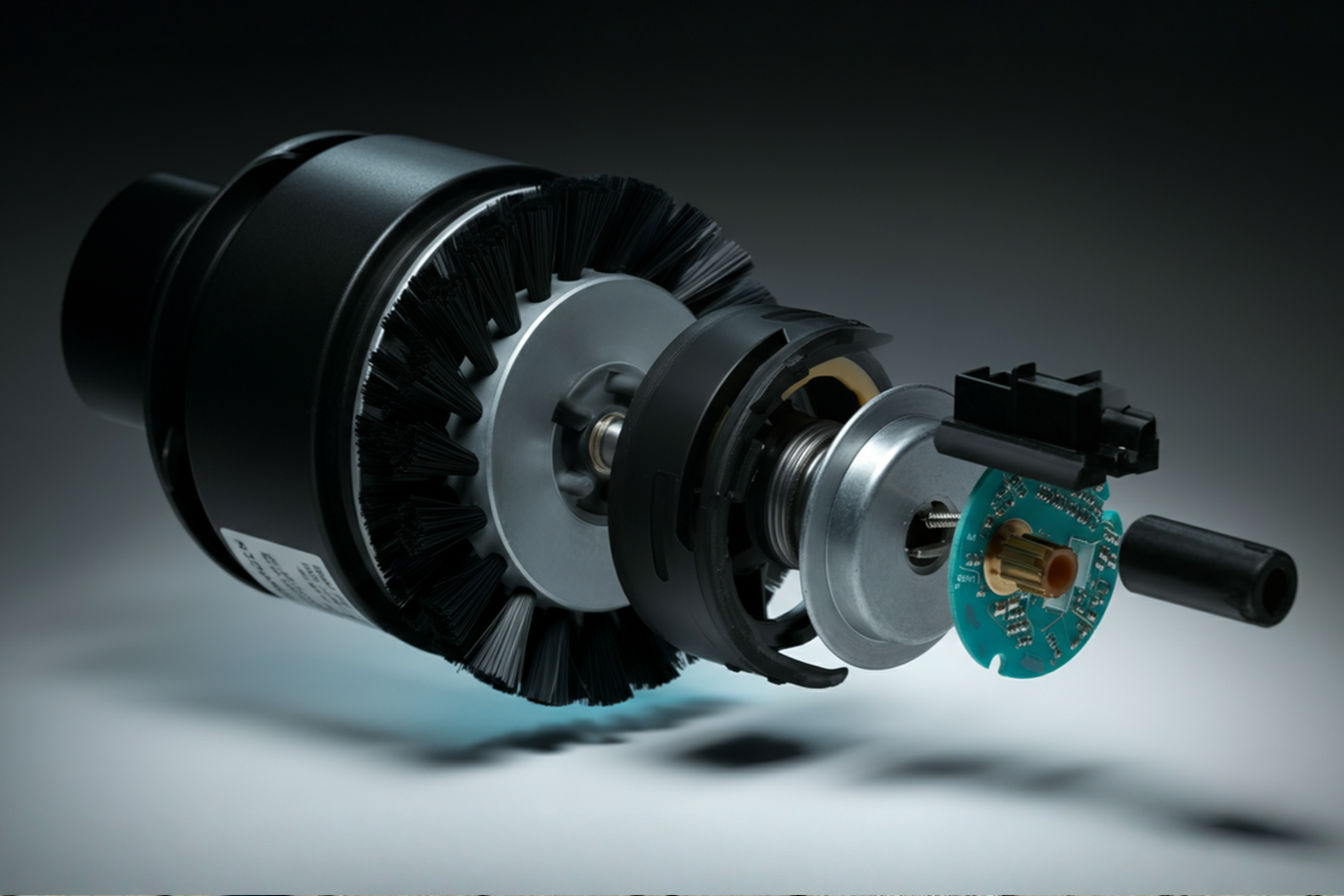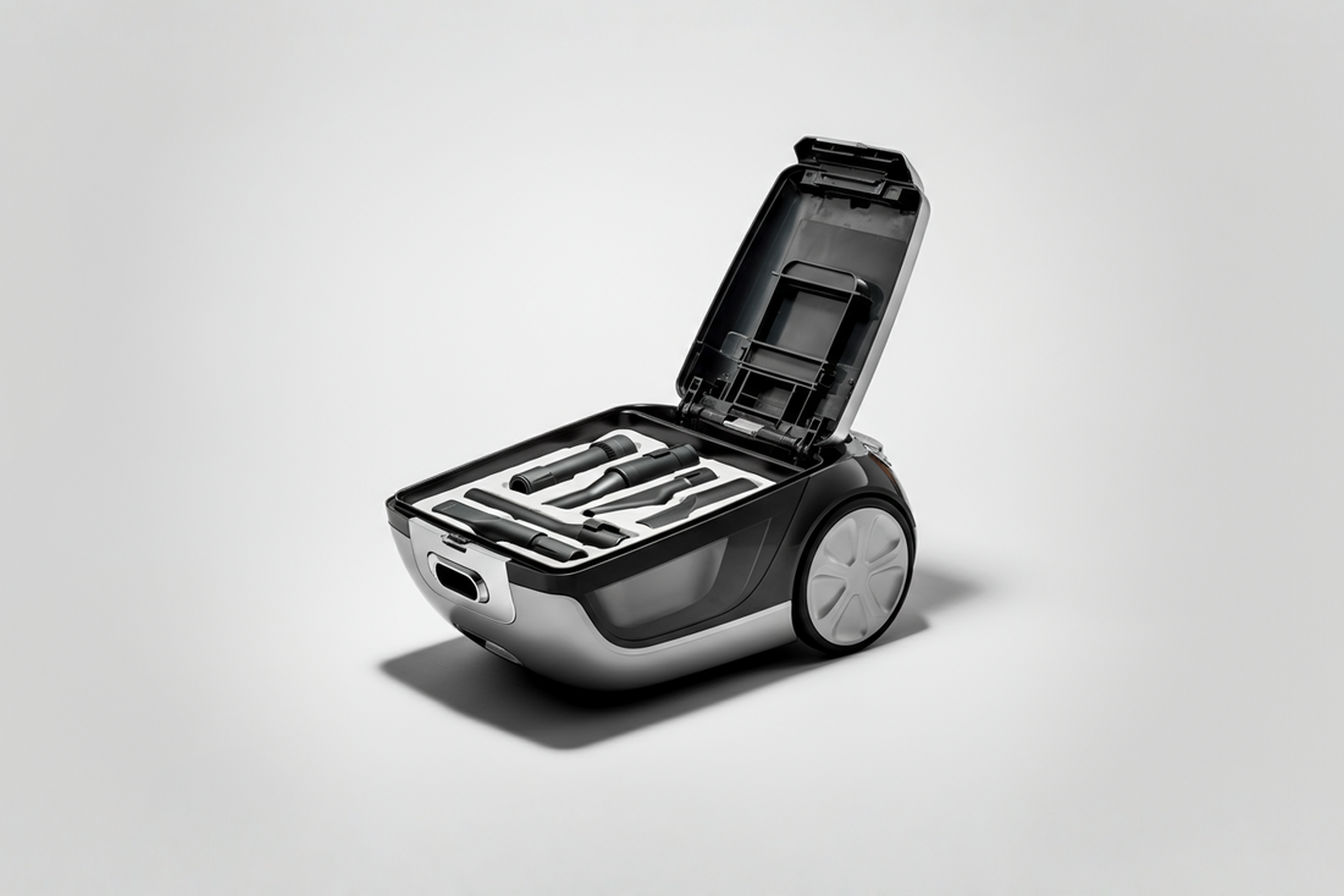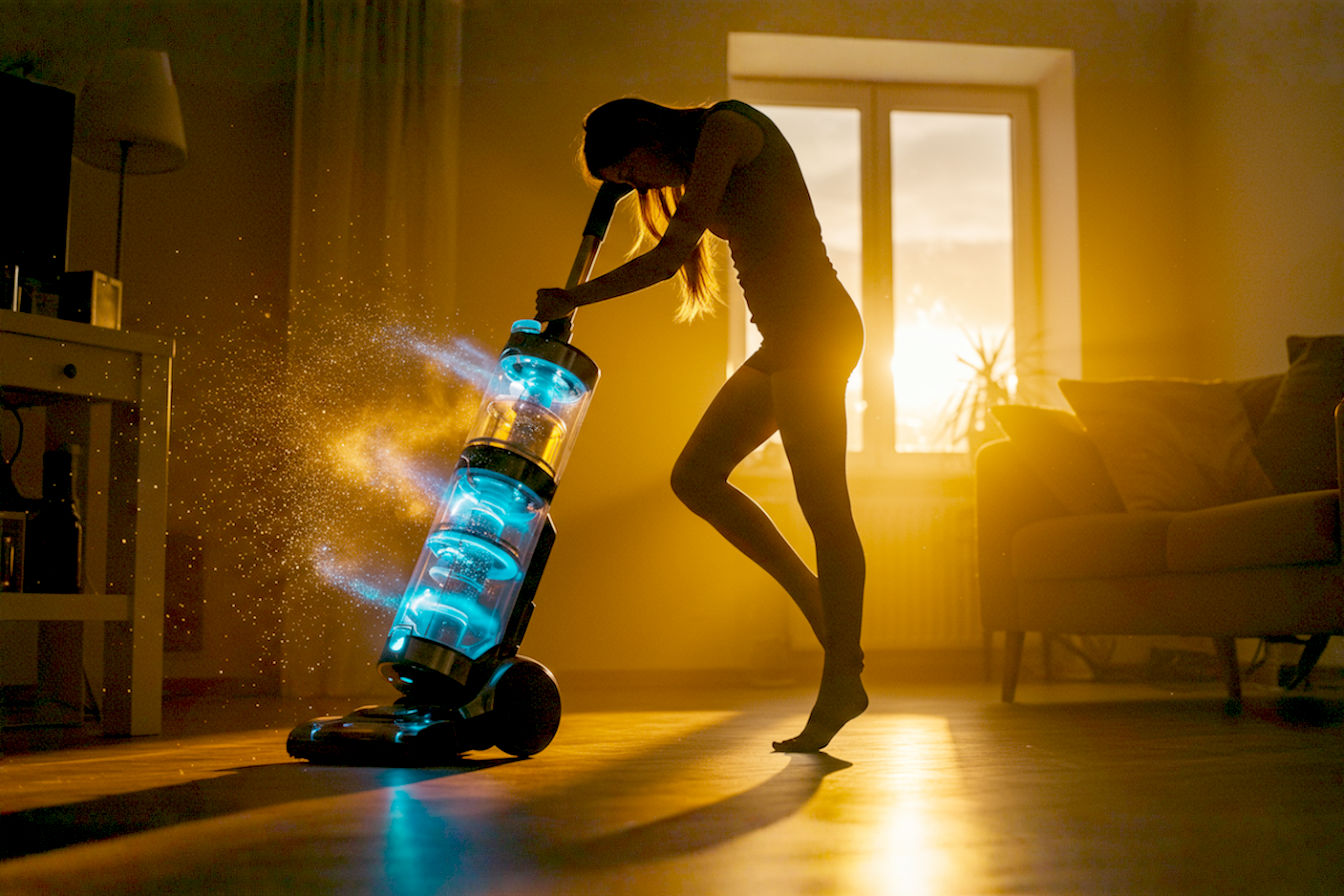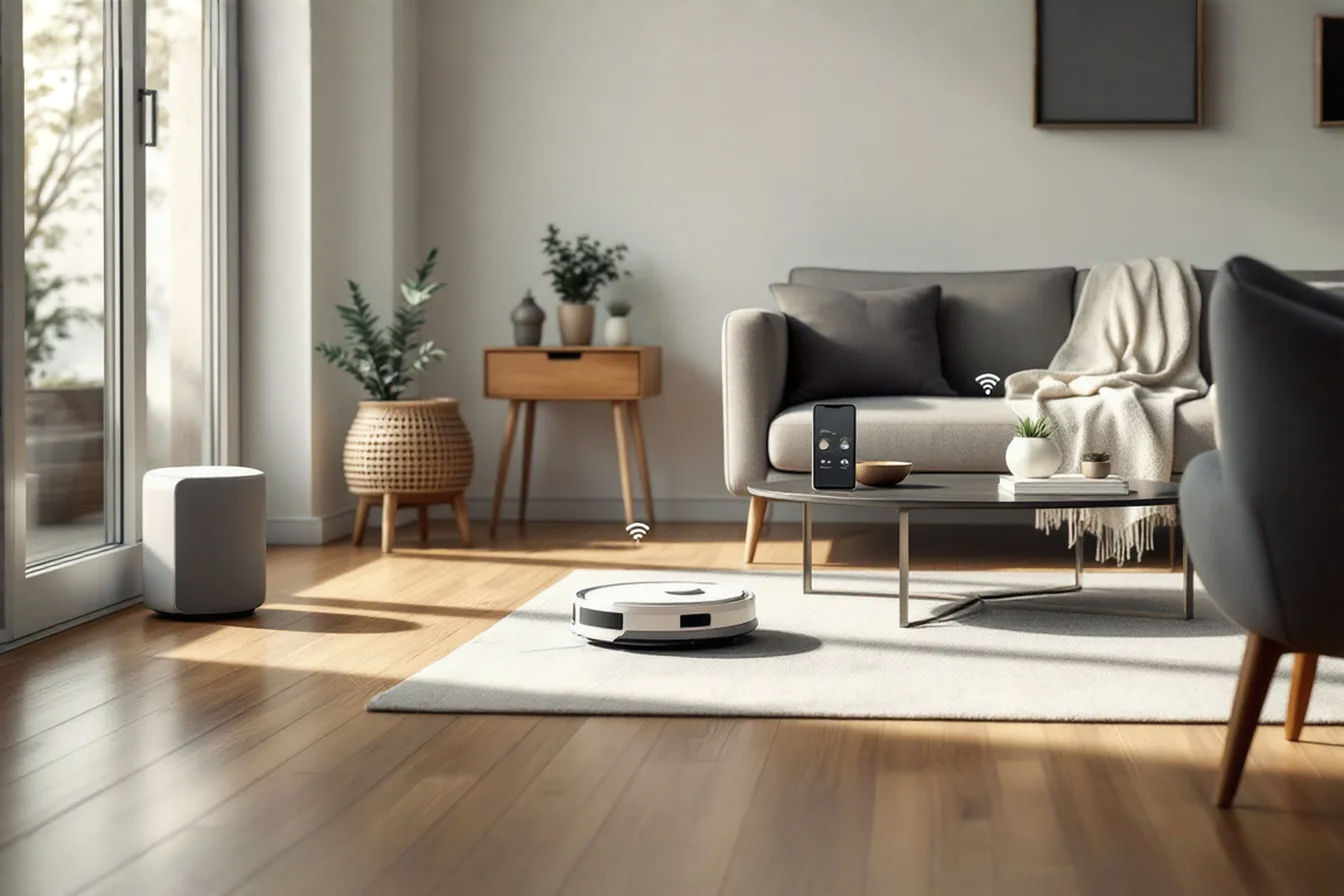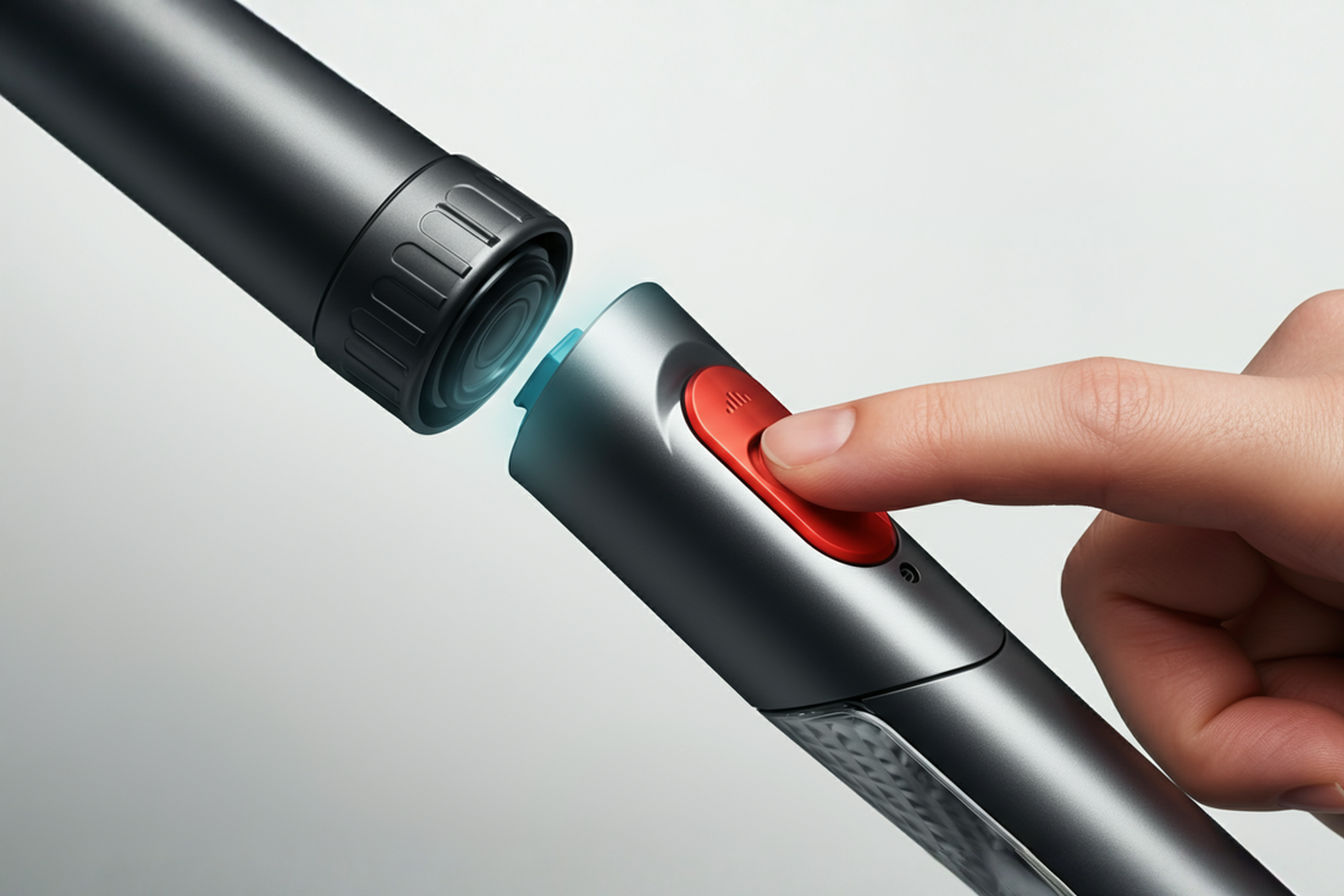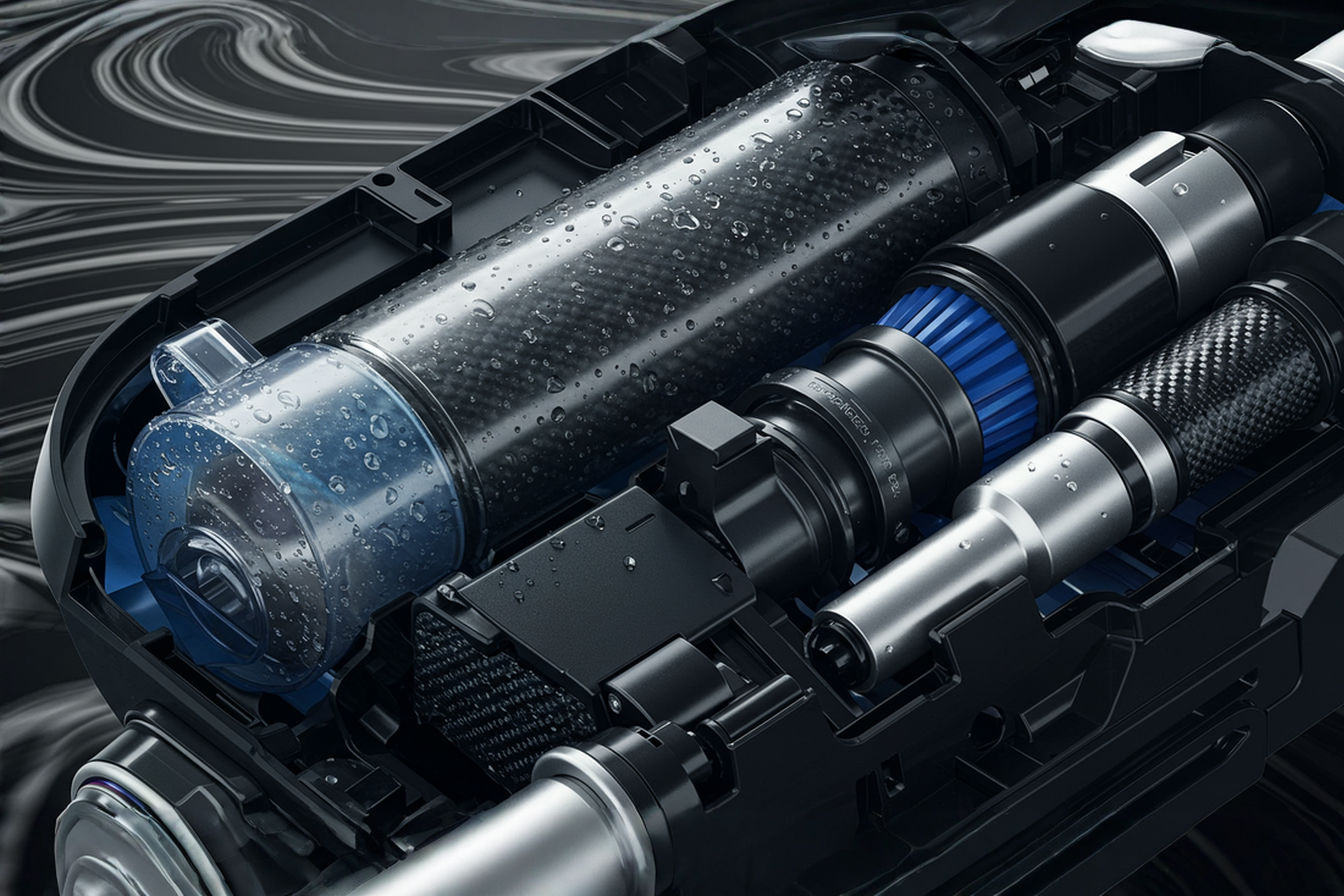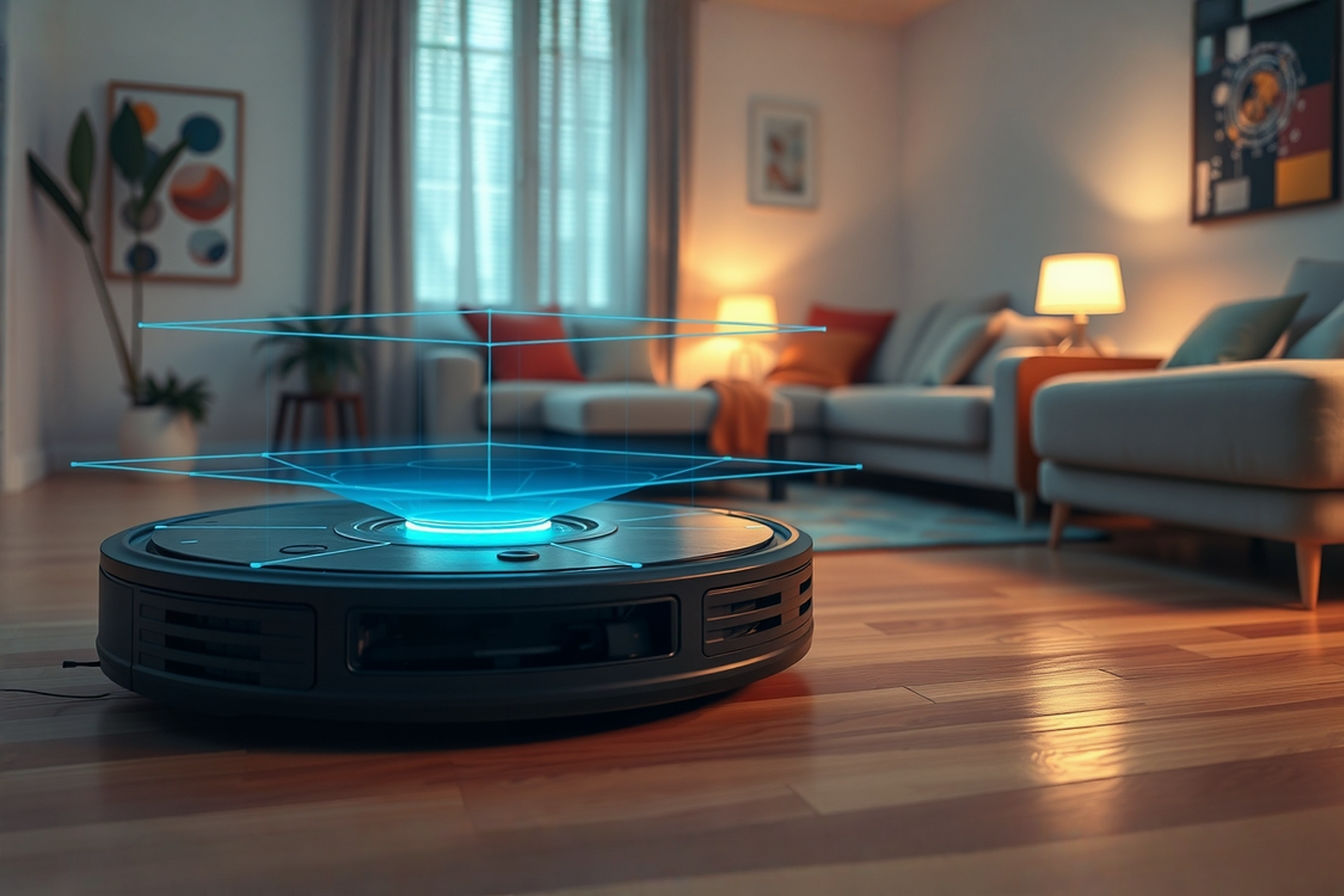Motorized Attachment Innovation: Adding Power Beyond the Main Vacuum
Explore how motorized vacuum attachments revolutionize home cleaning with specialized power beyond your main unit. From pet hair solutions to deep carpet cleaning, discover which powered tools deliver the best results.
This post may contain affiliate links. If you make a purchase through these links, we may earn a commission at no additional cost to you.
The humble vacuum cleaner has come a long way since its invention in the early 1900s. What began as a basic suction device has evolved into sophisticated cleaning systems with specialized tools for every surface and challenge in our homes. Perhaps the most significant leap forward has been the development of motorized attachments — tools that add their own power source beyond what the main vacuum provides.
These powered accessories represent a fundamental shift in how we approach challenging cleaning tasks. No longer limited by the suction power of the main unit, motorized attachments bring additional mechanical action directly to the cleaning surface. This innovation has transformed everything from pet hair removal to deep carpet cleaning.
In this comprehensive guide, we’ll explore the world of motorized vacuum attachments, including how they work, the different types available, their unique benefits, and how to choose the right ones for your specific cleaning needs. Whether you’re a cleaning professional looking to upgrade your toolkit or a homeowner seeking more effective solutions for stubborn messes, understanding these powered tools can dramatically improve your cleaning results.
Understanding Motorized Vacuum Attachments
What Makes an Attachment “Motorized”?
At its core, a motorized vacuum attachment is any accessory that incorporates its own power source to enhance cleaning performance. Unlike passive attachments that rely solely on the vacuum’s suction, motorized tools add mechanical action — typically in the form of rotating brushes, beaters, or other moving parts.
This seemingly simple addition creates a powerful combination: the vacuum’s suction removes the loosened debris while the motorized action actively dislodges dirt from surfaces. This teamwork approach tackles stubborn messes that suction alone can’t handle effectively.
Power Source Variations
Motorized attachments get their power in several different ways:
- Direct-powered attachments connect to the vacuum’s electrical system through specialized connectors in the hose or wand. These receive continuous power as long as they’re connected to the running vacuum.
- Air-driven (turbine) attachments use the vacuum’s airflow to spin a small turbine, which then powers the brush roll through a belt system. While technically “powered,” these aren’t true motorized attachments since they lack their own motor, but they’re often grouped with them.
- Battery-powered attachments contain their own rechargeable batteries, offering the ultimate flexibility. These can work with any vacuum system regardless of electrical connection compatibility.
- Hybrid power systems can switch between direct power when connected to compatible vacuums and battery power when used with non-compatible systems.
Core Components
Most motorized vacuum attachments share several key components:
- Motor unit – The heart of the attachment, delivering rotational power to the cleaning mechanism
- Brush roll or beater bar – Usually cylindrical with bristles, brushes, or rubber fins that rotate to agitate surfaces
- Housing/base plate – Contains the motor and provides the structure for the attachment
- Connection mechanism – Allows the attachment to interface with the vacuum wand or hose
- Height adjustment (on some models) – Allows customization of brush height for different surfaces
- Power control – May include speed settings or on/off switches
How They Differ From Standard Tools
The fundamental difference between motorized and standard attachments lies in their approach to dirt removal. Standard attachments create pathways for the vacuum’s suction to reach different surfaces. Motorized attachments actively participate in the cleaning process by mechanically agitating the surface to dislodge embedded dirt.
This difference becomes most apparent when dealing with:
- Embedded debris in carpet fibers that suction alone can’t pull free
- Clingy materials like pet hair that wrap around fibers rather than releasing easily
- Stubborn dirt that has worked its way into upholstery fabrics
- Static-prone surfaces where dust clings due to electrical charges
Types of Motorized Vacuum Attachments
The market offers a diverse range of motorized attachments, each designed for specific cleaning challenges. Here’s a breakdown of the most common types:
Mini Motorized Tools
These compact, handheld attachments typically feature a small motorized brush roll in a housing about 4-7 inches wide. Their smaller size makes them ideal for:
- Upholstery cleaning – Couches, chairs, and other fabric furniture
- Stair cleaning – Navigating the confined spaces of stair treads
- Vehicle interiors – Getting into car seats and floor mats
- Mattress refreshing – Removing dust mites and skin cells
Mini motorized tools often feature specialized brush designs to prevent damage to delicate fabrics while still providing effective agitation. Many modern models include LED lights to illuminate the cleaning area and reveal hidden dust.
Powered Floor Heads
These larger attachments replace the standard floor head and are designed specifically for floor surfaces:
- Carpet power brushes feature stiff bristles that dig deep into carpet fibers to release trapped dirt and debris. They often have wider cleaning paths (10-14 inches) than standard attachments.
- Hard floor motorized heads use softer brushes or microfiber rollers that polish while they clean, often with specialized debris channels for larger particles.
- Multi-surface power heads can adjust their brush action or height to transition between different flooring types without requiring attachment changes.
These tools often represent the most significant upgrade from standard vacuum tools, dramatically improving cleaning performance on larger floor surfaces.
Specialized Pet Hair Attachments
Pet owners face unique cleaning challenges, and manufacturers have responded with motorized attachments specifically designed for animal hair:
- Anti-tangle pet brushes use special brush designs or cutting mechanisms to prevent hair from wrapping around the roller
- Rubberized pet tools use static properties of rubber to attract and capture hair more effectively
- Grooming attachments can be used directly on pets (with appropriate precautions) to capture loose fur before it sheds
These specialized tools often feature stronger motors and more robust construction to handle the challenging nature of pet hair removal.
Deep Cleaning Brush Rolls
Some motorized attachments are designed specifically for periodic deep cleaning rather than regular maintenance:
- Carpet revitalizers use counter-rotating brushes to pull deep dirt from carpet fibers
- Extraction brush heads work with carpet cleaner machines, adding agitation to the water extraction process
- Stain scrubbers apply focused mechanical action to stubborn spots and stains
These specialized tools are often used less frequently but provide intensive cleaning power when needed.
Motorized Dusting Tools
A newer category of powered attachments focuses on dust removal from surfaces that benefit from gentle agitation:
- Motorized blind cleaners with rotating microfiber fingers that capture dust between blind slats
- Powered dusting brushes with soft, rotating bristles for delicate surfaces
- Electronic device cleaners with anti-static properties for computer keyboards and similar items
These tools represent innovation in an area previously dominated by passive attachments.
Emerging Innovative Attachments
The market continues to evolve with new specialized motorized tools appearing regularly:
- Sonic scrubbers that add ultrasonic vibration to break down stubborn dirt
- UV sterilizing brush heads that combine mechanical cleaning with germicidal light
- Smart motorized tools that can adjust their power or technique based on the detected surface or debris type
These cutting-edge tools point to future directions in vacuum attachment technology.
Benefits of Motorized Vacuum Attachments
The addition of motorized components to vacuum attachments delivers significant advantages that justify their typically higher cost. Understanding these benefits helps in making informed purchasing decisions.
Enhanced Debris Removal Capabilities
The most obvious benefit is simply better cleaning performance. Studies have shown that motorized brush rolls can remove up to 85% more embedded dirt from carpets compared to suction-only cleaning. This improved performance comes from:
- Mechanical agitation that actively dislodges trapped particles
- Brush design that reaches deeper into fibers and textures
- Combined action of rotation and suction working simultaneously
- Specialized surface interaction that adapts to different materials
For many users, this dramatic performance improvement is the primary motivation for investing in motorized attachments.
Time and Effort Savings
Beyond cleaning power, motorized attachments often make the cleaning process itself more efficient:
- Fewer passes needed to achieve the same cleanliness level
- Reduced physical effort as the motorized action does much of the work
- Faster completion of cleaning tasks through more efficient dirt removal
- Less manual pre-cleaning such as picking up pet hair by hand
For those with physical limitations or large areas to clean, these efficiency benefits can be particularly valuable.
Improved Performance on Specific Surfaces
Some surfaces present unique challenges that motorized attachments are specifically designed to address:
- High-pile carpets that standard suction struggles to penetrate
- Textured upholstery with deep crevices and folds
- Pet bedding that traps hair and dander deeply in fabric
- Vehicle carpeting that’s typically more densely constructed than home carpets
In these specialized applications, the difference between motorized and standard attachments is often dramatic.
Extended Reach and Maneuverability
Many modern motorized attachments incorporate design elements that improve their usability:
- Articulating joints that allow better navigation around furniture
- Swivel steering for improved control in tight spaces
- Self-propelling action that helps pull the attachment forward
- Edge-cleaning bristles that reach all the way to walls and corners
These design innovations make cleaning less physically demanding and more thorough.
Specialized Cleaning Abilities
Some cleaning challenges require specific mechanical actions that only motorized attachments can provide:
- Brushing action for different directions of carpet pile
- Vibrating motion to shake loose stubborn particles
- Counter-rotating brushes that grab stubborn debris more effectively
- Pulsing action that helps break up caked-on dirt
These specialized movements target specific cleaning challenges more effectively than general-purpose tools.
Common Applications and Best Uses
Motorized attachments shine in specific cleaning scenarios. Understanding these applications helps users maximize the value of their investment.
Pet Hair Removal Strategies
For pet owners, motorized attachments are often considered essential rather than optional. Effective strategies include:
- Using rubber-bristled motorized tools directly on furniture where pets rest
- Regular treatment of high-traffic pet areas with powered floor heads
- Addressing pet bedding weekly with mini motorized tools
- Creating a maintenance schedule for areas prone to hair accumulation
Many pet owners report that upgrading to motorized pet tools has been the single most impactful change in managing pet hair in their homes.
Deep Cleaning Upholstery and Furniture
Fabric furniture presents unique cleaning challenges that motorized attachments address effectively:
- Removing embedded dirt that accumulates from regular use
- Extracting allergens that become trapped in fibers
- Refreshing appearance by lifting crushed pile
- Addressing stains with specialized brush action
For best results, use slow, methodical passes across upholstery surfaces, allowing the brush to work thoroughly on each section.
Stair Cleaning Optimization
Stairs combine difficult access with heavy traffic, making them particularly challenging to clean effectively:
- Mini motorized tools allow detailed cleaning of both treads and risers
- Cordless motorized attachments eliminate the safety hazard of cords on stairs
- Edge-cleaning features help address the often-neglected corners of each step
- Lightweight designs reduce fatigue during this physically demanding cleaning task
Many users reserve their motorized attachments specifically for stair cleaning, even if they use standard tools elsewhere.
Vehicle Interior Detailing
Car interiors combine confined spaces with deeply embedded dirt, making them perfect candidates for motorized cleaning:
- Between and under seats where debris accumulates
- Headliners and door panels that can trap dust
- Floor mats and carpeting that collect outdoor debris
- Trunk areas that may contain deeply embedded dirt
Battery-powered motorized attachments are particularly valuable for vehicle use, eliminating the need for long extension cords.
Mattress and Fabric Surface Revitalization
Beds and other fabric surfaces benefit greatly from the deep cleaning action of motorized attachments:
- Removing dust mites and allergens from mattress surfaces
- Extracting dead skin cells that accumulate over time
- Refreshing pillows and bedding between washings
- Addressing dust in decorative items like throw pillows that are rarely cleaned
Monthly mattress cleaning with a motorized attachment is recommended by many allergists for patients with dust sensitivities.
Small Space and Hard-to-Reach Area Solutions
Some cleaning challenges involve difficult access rather than stubborn dirt:
- Reaching under low furniture without moving heavy items
- Cleaning between radiator fins or similar tight spaces
- Addressing ceiling corners and other overhead areas
- Navigating narrow spaces between appliances
Specialized slim motorized attachments are designed specifically for these accessibility challenges.
Technology Behind Powered Attachments
Understanding the technical aspects of motorized attachments helps in selecting the right tool and maximizing its lifespan through proper use and care.
Motor Types and Performance Factors
The heart of any motorized attachment is its motor, which comes in several varieties:
- DC brush motors – Traditional technology, moderately powerful but with more maintenance needs due to carbon brushes that wear over time
- Brushless DC motors – Newer technology that lasts longer, runs cooler, and often delivers more power in a smaller package
- Pancake motors – Ultra-flat designs that allow for very low-profile attachments
- Micro motors – Specialized tiny motors for the smallest motorized tools
Key performance factors include:
- RPM (rotations per minute) – Typically ranging from 2,500-8,000 RPM for consumer models
- Torque rating – Determines how well the brush handles resistance from carpet or debris
- Power consumption – Affects battery life in cordless models
- Heat management – Better cooling systems allow longer continuous operation
Higher-end attachments typically feature more sophisticated motors with better overall performance characteristics.
Battery Technology Advancements
For battery-powered attachments, recent innovations have dramatically improved performance:
- Lithium-ion cells have largely replaced older NiCad and NiMH batteries, offering:
- 3-5 times longer runtime
- No memory effect
- Lighter weight
- Faster charging
- Smart battery management systems optimize performance by:
- Regulating power output
- Preventing overheating
- Extending battery lifespan
- Providing charge level indicators
These advancements have made battery-powered attachments viable alternatives to direct-powered options in many applications.
Smart Features and Electronic Integration
Modern motorized attachments increasingly incorporate electronic systems beyond basic power delivery:
- Surface detection technology that adjusts brush speed for different floor types
- Debris sensors that increase power when encountering concentrated dirt
- LED notification systems that alert users to clogs or maintenance needs
- Digital control systems offering multiple power settings
- App integration in premium models for usage tracking and maintenance reminders
These smart features optimize cleaning performance while extending equipment life through proper usage guidance.
Design Innovations That Improve Functionality
Engineering advancements continue to enhance the practical aspects of motorized attachments:
- Anti-tangle systems with specially designed brush bars that resist hair wrapping
- Self-cleaning brush rolls that automatically remove hair and fibers
- Lightweight materials that reduce user fatigue
- Improved air channel design that maintains suction while powering brushes
- Noise reduction technology for quieter operation
These practical innovations address common pain points from earlier generations of motorized tools.
Interface Mechanisms with Main Vacuum Units
The connection between motorized attachments and the main vacuum is a critical but often overlooked component:
- Electrical contact systems must maintain reliable connections while being repeatedly attached and detached
- Air channel design ensures proper suction flow through the attachment
- Mechanical coupling strength must support the weight and forces of the motorized tool
- Quick-release mechanisms balance security with ease of changing attachments
Premium vacuum systems often feature more robust connection systems designed for frequent attachment changes and heavy use.
Compatibility and Universal Design
One of the more confusing aspects of motorized attachments is understanding which tools will work with which vacuum systems. This section helps navigate these compatibility challenges.
Understanding Attachment Systems Across Brands
Most major vacuum manufacturers use proprietary connection systems:
- Dyson uses bayonet-style twist-lock connections with electrical contacts
- Shark employs a button-lock system with separate electrical connectors
- Miele features a hexagonal connection with integrated power delivery
- Electrolux/AEG uses a button-lock system with concentric electrical rings
- Hoover/Dirt Devil utilizes various locking tab designs depending on the model
These different systems create inherent compatibility limitations between brands.
Universal Adapters and Conversion Options
Several solutions exist to overcome cross-brand compatibility issues:
- Universal adapters – Physical connectors that bridge different attachment systems
- Power converters – Devices that adapt electrical connections between systems
- Third-party attachment lines – Companies like Wessel-Werk and Lindhaus produce attachments compatible with multiple brands
- DIY adapter solutions – 3D-printed adapters have become increasingly available online
When purchasing adapters, it’s important to verify both physical fit and electrical compatibility, as these are separate issues.
Proprietary Systems vs. Standardized Connections
The vacuum industry continues to move slowly toward more standardized connections:
- 1.25″ and 1.375″ round tool fittings have become semi-standard for non-powered attachments
- 32mm and 35mm connections are common European standards
- PowerFlow standard is an attempt at creating an industry-wide powered connection system, though adoption remains limited
This standardization progress benefits consumers by expanding attachment options beyond the original manufacturer’s offerings.
Compatibility Considerations When Purchasing
When investing in motorized attachments, several compatibility factors should be evaluated:
- Physical connection compatibility – Will the attachment physically connect to your vacuum?
- Electrical compatibility – If direct-powered, will it receive power from your system?
- Voltage/power matching – Does the attachment require power levels your vacuum can provide?
- Airflow requirements – Does your vacuum generate sufficient airflow for optimal attachment performance?
- Weight balance – Is your vacuum designed to handle the weight of the attachment?
Answering these questions before purchase prevents costly compatibility mistakes.
Cross-Brand Compatibility Charts and Resources
Several helpful resources exist to navigate the complex world of attachment compatibility:
- Manufacturer compatibility charts (available on most vacuum maker websites)
- Third-party adapter manufacturers’ fit guides
- Vacuum forum databases with user-verified compatibility information
- YouTube channels dedicated to vacuum attachment testing
- Specialty vacuum retailer guidance
These resources can help identify compatible options beyond what the original vacuum manufacturer offers.
Buying Guide: Selecting the Right Motorized Attachments
With so many options available, choosing the right motorized attachments requires careful consideration of your specific needs and budget.
Assessing Your Specific Cleaning Needs
Before shopping, consider your particular cleaning challenges:
- Floor surface types in your home (carpet types, hard flooring varieties)
- Furniture materials that require cleaning (leather, different fabric types)
- Pet situations (number, breed, shedding characteristics)
- Allergy considerations that might require more frequent deep cleaning
- Problem areas in your home that never seem to get completely clean
This assessment helps prioritize which motorized attachments will deliver the greatest benefit for your situation.
Balancing Cost vs. Performance
Motorized attachments represent a significant investment, with prices ranging from:
- Budget options ($30-60) – Basic functionality, typically less durable
- Mid-range attachments ($60-120) – Good performance balance for most homes
- Premium tools ($120-250+) – Professional-grade performance with advanced features
To maximize value, consider:
- Frequency of use – Higher investment makes sense for tools used weekly
- Expected lifespan – Better construction often correlates with longer service life
- Performance difference – Some premium features provide tangible benefits while others are conveniences
- Warranty coverage – More expensive attachments typically offer better protection
For many users, investing in one high-quality motorized attachment delivers better value than multiple budget options.
Key Features to Consider Before Purchasing
Beyond basic functionality, several features differentiate motorized attachments:
- Brush roll design – Different bristle patterns work better for specific applications
- Width/size – Larger isn’t always better, especially for maneuverability
- Power options – Battery, direct-power, or air-driven each have advantages
- Ease of maintenance – Some designs allow simple brush roll removal for cleaning
- Noise level – Particularly important for households with sensitive individuals or pets
- Weight – Affects usability, especially for extended cleaning sessions
- Edge cleaning capability – Important for baseboards and corners
- Headlights – Valuable for revealing dust in low-light areas
Prioritize features that address your specific cleaning challenges rather than focusing on specifications alone.
Recommended Attachments for Different Home Environments
Different living situations benefit from specialized attachment selections:
For Pet-Heavy Households:
- Mini motorized tool with anti-tangle design
- Full-size powered floor head with specialized pet hair features
- Rubberized pet tool for furniture
For Allergy Sufferers:
- HEPA-filtered motorized mattress tool
- Sealed-system powered floor head
- Specialized upholstery tool with allergen-capture features
For Homes with Varied Flooring:
- Multi-surface powered floor head with height adjustment
- Specialized hard floor motorized brush
- Corner-cleaning motorized attachment
For Apartments or Smaller Spaces:
- Compact motorized hand tool with multiple attachments
- Slimline powered floor head for navigating tight spaces
- Stair-specific motorized tool
Matching tool selection to your specific environment maximizes cleaning effectiveness.
Professional Recommendations for Specific Cleaning Challenges
Professional cleaners often have specific attachment recommendations for challenging situations:
- For ground-in carpet stains: Oscillating brush tools that combine agitation with cleaning solution application
- For persistent pet odors: UV-equipped motorized tools that identify and treat biological residues
- For delicate upholstery: Variable-speed motorized tools with ultra-soft bristles
- For high-traffic commercial areas: Heavy-duty motorized attachments with metal construction and replaceable brushes
These specialized tools may be worth the investment for persistent cleaning challenges.
Maintenance and Care
Proper maintenance significantly extends the life of motorized attachments while ensuring optimal performance.
Cleaning Procedures for Motorized Parts
Regular cleaning prevents performance degradation and mechanical problems:
- Brush roll cleaning – Remove wound hair and fibers after every 1-2 uses
- Housing wiping – Clean the attachment base to prevent debris buildup
- Air channel clearing – Ensure pathways remain free of obstructions
- Bearing/axle inspection – Keep rotation points clean and lubricated if recommended
- Electrical contact cleaning – Gently clean connection points with appropriate electronic contact cleaner
Most manufacturers recommend a more thorough monthly cleaning in addition to regular quick maintenance.
Extending Brush and Motor Life
Several practices dramatically extend the working life of motorized components:
- Avoid overheating by following recommended continuous use guidelines
- Start and stop the brush properly – Turn off before lifting from surfaces
- Use appropriate brush height settings for different surfaces
- Clean brushes immediately after picking up string, thread, or hair
- Store properly – Hang attachments rather than resting on brush bristles
These simple habits can double or triple the functional lifespan of motorized attachments.
Troubleshooting Common Issues
When problems arise, systematic troubleshooting often resolves them without repair expenses:
- Brush not spinning:
- Check for obstructions in the brush mechanism
- Verify electrical connections are clean and properly seated
- Inspect drive belt if applicable
- Test outlet/vacuum power if direct-powered
- Poor cleaning performance:
- Examine brush for wear or damage
- Check for partial clogs reducing airflow
- Verify brush height is appropriate for surface
- Ensure brush is spinning at proper speed
- Unusual noise:
- Look for foreign objects caught in the brush or housing
- Check for bearing wear
- Inspect gear mechanisms for damage
- Verify all housing parts are properly secured
Most issues can be resolved through simple maintenance rather than replacement.
When to Replace vs. Repair Components
Understanding which parts are worth repairing helps make cost-effective decisions:
- Typically replaceable components:
- Brush rolls (often available as separate parts)
- Drive belts
- Wheels and roller assemblies
- Housing components
- Usually not worth repairing:
- Burned-out motors in budget attachments
- Cracked main housings
- Failed electrical components in older models
- Extensively damaged gear assemblies
As a general rule, when repair costs exceed 50% of replacement cost, purchasing new is usually more economical.
Storage Best Practices
Proper storage prevents damage and extends attachment life:
- Store hanging when possible rather than resting on brushes
- Keep in dry environments to prevent corrosion of motor components
- Remove batteries from attachments not used regularly
- Detach from main vacuum rather than storing connected
- Use protective caps if provided with the attachment
These simple practices prevent unnecessary wear during storage periods.
Future Trends in Motorized Vacuum Attachments
The technology continues to evolve rapidly, with several clear trends emerging in the marketplace.
Emerging Technologies and Innovations
Several cutting-edge technologies are beginning to appear in consumer-level motorized attachments:
- Microprocessor-controlled brushes that adjust thousands of times per second to surface conditions
- Sensors that detect debris type and adjust cleaning action accordingly
- Anti-microbial brush materials that resist bacterial growth
- Self-cleaning mechanisms that actively prevent hair entanglement
- Advanced materials like carbon fiber components for lighter weight and higher durability
These innovations represent the next generation of motorized cleaning technology.
Cordless and Battery Improvements
Battery technology continues to advance rapidly, changing what’s possible with powered attachments:
- Higher energy density cells allow more power in smaller packages
- Fast-charging technology reduces downtime between uses
- Battery management systems that optimize performance based on cleaning needs
- Modular battery design that allows sharing power sources between tools
- Solar charging integration for environmentally conscious options
These advancements are rapidly making corded attachments obsolete for many applications.
Smart Home Integration Possibilities
Motorized attachments are beginning to connect with broader smart home ecosystems:
- Usage tracking that integrates with cleaning schedules and reminders
- Performance monitoring that alerts users to maintenance needs
- Voice control compatibility with major smart home platforms
- Cleaning pattern optimization based on home layout data
- Integration with air quality monitors to trigger cleaning when needed
This connectivity transforms motorized attachments from isolated tools to components in whole-home management systems.
Sustainable Design Approaches
Environmental considerations are influencing attachment design in several ways:
- Energy efficiency improvements that reduce power consumption
- Recyclable component design that facilitates end-of-life processing
- Biodegradable brush materials from plant-based sources
- Repairability features that extend useful life
- Reduced packaging and eco-friendly manufacturing processes
These sustainability initiatives are becoming increasingly important purchase factors for many consumers.
What’s Next in Powered Cleaning Tools
Looking further ahead, several innovations appear on the horizon:
- AI-powered cleaning technology that learns your home’s specific needs
- Autonomous attachment technology that works in conjunction with robotic systems
- Advanced filtration integration combining mechanical cleaning with air purification
- Specialized surface treatment beyond simple cleaning (polishing, sanitizing, protecting)
- Augmented reality guidance for optimal cleaning technique
These future directions point to motorized attachments becoming increasingly sophisticated cleaning systems rather than simple mechanical tools.
Conclusion
Motorized vacuum attachments represent one of the most significant advancements in home cleaning technology, bridging the gap between traditional vacuum systems and specialized cleaning needs.
Summary of Key Benefits
The advantages these powered tools provide include:
- Superior cleaning performance on challenging surfaces and debris types
- Time and effort savings through more efficient cleaning processes
- Extended cleaning capabilities beyond what standard attachments can provide
- Specialized solutions for specific cleaning challenges like pet hair and allergies
- Improved accessibility to difficult cleaning areas
For many users, these benefits justify the additional investment compared to standard attachments.
Making the Most of Your Motorized Attachments
To maximize the value of powered accessories:
- Develop regular maintenance habits to ensure optimal performance
- Use the right attachment for each specific task rather than a one-tool approach
- Follow manufacturer recommendations for usage techniques
- Consider investing in quality over quantity when building your attachment collection
- Keep up with cleaning frequency recommendations to prevent deep soil buildup
With proper selection and use, motorized attachments can dramatically improve cleaning results while reducing the time and effort required.
Final Recommendations for Different User Types
For Budget-Conscious Homeowners: Start with a quality mini motorized tool that can handle multiple surfaces, adding specialized tools as budget allows.
For Pet Owners: Invest first in a high-quality pet hair attachment with anti-tangle features, which will likely become your most frequently used tool.
For Allergy Sufferers: Prioritize sealed-system motorized attachments with HEPA filtration capabilities for mattresses and upholstery.
For Cleaning Professionals: Develop a comprehensive kit with specialized attachments for different surface types, focusing on durability and performance.
Motorized attachments continue to evolve, with each generation offering improved performance, durability, and specialized features. By understanding the technology, applications, and maintenance requirements, users can transform their cleaning results while reducing the time and effort required to maintain their homes.

